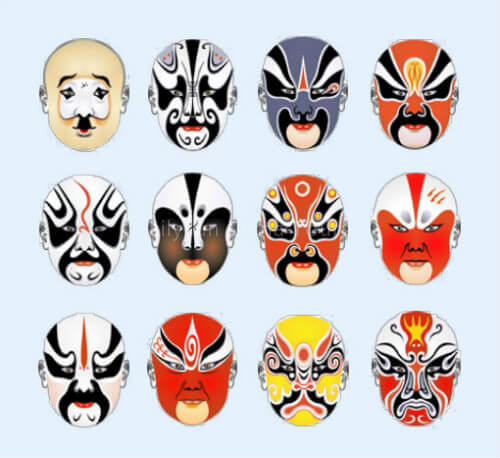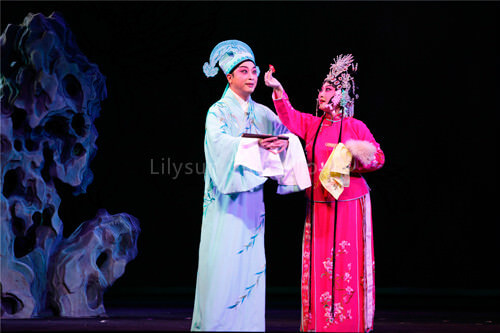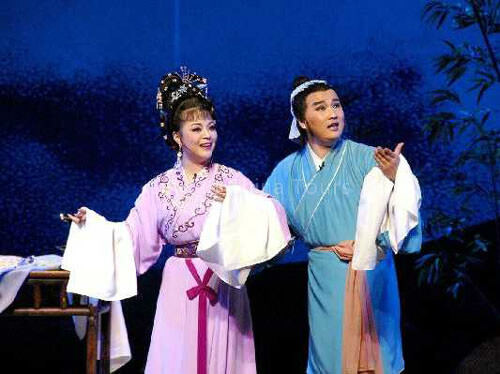Chinese Opera has a long history, and there are about 360 types of local operas all over China. Beijing Opera, Yue Opera, Yu Opera, Ping Opera, and Huangmei Opera are regarded as the five most popular operas in China.
Peking Opera is one of the five most popular operas in China and the quintessence of Chinese culture. It has Xipi and Erhuang, two kinds of significant tunes, with accompaniments of Huqin (vertical lute), gongs, and drums.

Peking Opera originated in Anhui province. Its predecessor is Hui Opera. From the fifty-fifth year (1790) of Qianlong's reign, four famous Hui opera troupes (Sanqing, Sixi, Chuntai, and Hechun) entered Beijing. They worked with Han Tune artists from the Hubei province and absorbed partial operas, tunes, and performing methods from Kunqu Tune and Qinqiang, finally forming the Peking Opera. Since then, Peking opera began to develop rapidly and prospered in Qing court until the Republic of China. Nowadays, Peking Opera is not only famous in China, but all over the world. It became an important medium to spread traditional Chinese culture. On Nov.16, 2020, Beijing Opera was included in the UNESCO's Representative List of the Intangible Cultural Heritage of Humanity.
Through the long-term practices of Peking Opera, a system of restrictive yet harmonious compositions and formulas were standardized in terms of literature, performance, music, singing tune, instruments, makeups, and masks. Performing art is a combination of virtuality and reality. It transcends the space and time limitations of the stage to reach a state of "combination of body and mind." In terms of performing, it must be delicate and refined. In terms of singing tune, it must be lyrical and emotional.
There are four means of artistic expression in Peking opera performance, Singing (唱), Chanting (念), Gesturing (做) and Fighting (打), also called the four basic skills of Peking Opera. All the performers are trained with these four basic skills.
Singing is pretty easy to understand.
Chanting refers to the spoken parts of the Peking opera.
Gesturing refers to body movements.
Fighting refers to the acrobatic action and tumble of the opera.
The singing and chanting form the opera's singing part, while the gesturing and fighting form the opera's dancing part.
Everything on the stage of Peking Opera is arranged based on the roles' gender, personality, age, occupation, and social status, and exaggerated in various aspects like makeup and costume. There are four types of parts, Sheng, Dan, Jing, and Chou, respectively.
Sheng
It's the collective term for positive male characters except for the Hualian (male roles with a painted face) and Choujue (harlequin). There are also different kinds of Sheng roles, like Laosheng (old male characters), Wusheng (fighting male characters), Xiaosheng (young male characters), and Wawa Sheng (young boy characters).
Dan
It's the collective term for positive female characters. There are different Dans like Qingyi (Zhengdan, the main female role), Huadan (lively and confidant young or middle-aged female roles), Guimen Dan (maiden characters), Daoma Dan (female characters with military skills), Wudan (heroine characters), and Caidan (comical funny female characters or old lady roles).
Jing
Commonly known as Hualian, Jing refers to the male characters with distinct features in nature or appearance. Such characters are rough, usually have a resonant sound, and wear facial makeup. Jing mainly includes Wenjing (male characters with wisdom) and Wujing (fighting male characters with distinct characteristics).
Chou
It refers to the comical characters of the opera. Most of such characters wear a small piece of white powder on the bridge of their nose.
Classifications
|
Facial Makeup Color |
Representations |
|
Red Facial Makeup |
Loyalty and bravery |
|
Black Facial Makeup |
Valiant and intelligence |
|
Blue and Green Facial Makeups |
Greenwood heroes |
|
Yellow and White Facial Makeups |
Treacherousness and malevolence |
|
Golden and Silver Facial Makeups |
Mysterious gods or ghosts. |
There are three basic painting methods in Peking Opera makeups, namely rubbing, wiping, and tracing. The original functions of the opera facial makeups were to exaggerate the characters' personality, mentality, and physical features by exaggerating the characters' face. Later, the facial makeup became more complex, delicate, and profound and grew to be a facial pattern art with distinct national characteristics.

The accompaniments of Peking Opera mainly include percussion instruments and orchestral instruments.
The percussion instruments include a plate, single leather drum, big gong, big cymbals, and cymgong.
The orchestral instruments include the Beijing opera fiddle, Erhu, Moon Lute, and trichord.
Representative personages:
Three Outstanding Laosheng Performers: Cheng Changgeng, Yu Sansheng, and Zhang Erkui;
Three New Outstanding Laosheng Performers: Tan Xinpei, Wang Qiufen, and Sun Juxian.
Four Famous Dan Performers: Mei Lanfang, Gou Huisheng, Cheng Yanqiu, and Shang Xiaoyun.
Representative masterpieces: Long Feng Cheng Xiang ( Dragon and Phoenix Bringing Prosperity), Qun Ying Hui (Gathering of Heroes), Guifei Zui Jiu (The Drunken Concubine), Silang Tan Mu (Yang Silang Visits His Mother), and Bawang Bieji (Farewell To My Concubine).
Yue Opera, one of the five most popular operas in China, originated in Shengzhou, thrived in Shanghai, and prevailed in Jiangsu, Zhejiang, and Shanghai. The early Yue Opera only used male actors. After entering Shanghai, the Yue operas performed by female actors grew popular among people. Thus, female actors dominated the Yue opera until the founding of the People's Republic of China, when male actors began to be also recruited again. Still, female actresses are in the majority. Yue opera is famous for its melodic and mellow tunes, and the themes are mostly about gifted scholars and beautiful ladies.

Six Major Roles of Yue Opera - Xiaosheng, Xiaodan, Laosheng, Laodan, Xiaochou, and Damian.
Xiaosheng and Xiaodan are the major roles in Yue operas.
Xiaodan: young female characters.
Xiaosheng: young male characters.
Laosheng: old male characters.
Laodan: old female characters.
Xiaochou: comical characters.
Damian: mostly the treacherous characters, sometimes the upright characters.
Yue opera features lyrical singing, melodious and beautiful sound, elegant and vivid performance.
Yue opera's main instruments are clapper boards and Yuehu; besides these, there are also Chinese dulcimer, Erh-hu, Zhonghu, and cello.
Yue opera's facial makeup combined traditional gouache makeup and the makeup used in movies and dramas. Oil paints were mainly used but in a lively and bright style. For female characters, the special headgear costumes resembling the costumes of ancient ladies in paintings were used. The facial makeups of Yue opera are more lifelike, which is very different from other Chinese operas.
Yue opera's costumes are all delicate, simple, and elegant, and their colors are mostly simple intermediate colors. There are not many decorations on the outfits. The female characters' costumes mostly take examples from the traditional Chinese portrait paintings and traditional arts. Non-reflective fabrics are used the most.
Yu Opera, one of the five major operas in China, originated in Kaifeng, Henan province. It inherited, reformed, and developed the Henan Bangzi (local operas performed to the accompaniment of wooden clappers) and was renamed as Yu Opera after founding the People's Republic of China. It's famous for its sonorous, forceful, cadenced, hearty, articulating, and lively aria and excels in expressing the inner emotions of characters.

The roles types of Yu Opera is similar to that of Peking Opera. There are also four same types of roles, and each has identical divisions. Generally speaking, the opera troupe is composed of four Shengs, four Dans, four Hualians (painted faces). A stage can be composed of four Shengs, four Dans, four Hualians (painted faces), four soldiers, four generals, four maids, and four handymen.
The stage setting of the early Yu Opera performance was extremely simple. A piece of reed or bamboo mat was used to block the backstage, and one table and two chairs were used as stage property; the show thus began. The persons hitting gongs and clappers were also in charge of other things. Later, with the development of Yu opera, the stage settings were improved.
The facial makeups of Yu Opera are usually heavy and robust. No matter what kind of role they are playing, oil paints are always applied heavily. The characters of Dans usually have almond-shaped eyes with eyeliners as long as reaching the ears and small cherry lips. The various facial makeups for Sheng roles are just dazzling.
The costumes for Dan's roles stressed the principle of insipid costumes for Laodan, beautiful costumes for Zhengdan, and dissolute costumes for Huadan. Nowadays, influenced by Peking Opera, Yu opera's costumes are the same as Peking Opera costumes.
String and Wind Instruments:
In early Yu opera performances, big string (octagonal moon lute and suona horn), two-stringed plucked instrument (high-pitched fiddle), and three-stringed plucked instrument were used. Since the 1930s, the high-pitched fiddle became the main instrument. After the 1950s, more instruments like Erh-hu, Pipa, Bamboo Flute, reed pipe wind instrument, cello, zheng, violin, electric organ, and others were added.
Percussion Instruments: Gong and Drums.
Gongs and Drums were mainly used to perform gong and drum drops on three occasions: opening for the performance, accommodating the actions and render stage atmosphere (similar to the Peking opera), and accompanying the singing.
Representative personages
Six Outstanding Dan Performers: Chang Xiangyu, Chen Suzhen, Cui Lantian, Ma Jifeng, Yan Lipin, and Sang Zhenjun.
Three Outstanding Xiaosheng Performers: Zhao Yiting, Wang Fujun, and Wang Xiling.
Five Outstanding Xusheng Performers: Tang Yucheng, Tang Xicheng, Liu Zhonghe, Liu Xinmin, and Li Shujian.
Five Protagonists of Yu Opera in modern times: Gao Jie, Ma Lin, Wei Yun, Wang Shanpu, and Liu Lanfang.
Representative masterpieces
Hong Niang (Matchmaker), Hua Mulan, Lady General Mu Takes Command and many more.
Ping Opera is a local opera popular in northern China. It originated in Luanxian county, Hebei, in the late Qing Dynasty. In the 1920s, Ping opera prevailed in northeast China. Decades later, under the impact of Peking Opera and Hebei Bangzi, Ping opera became mature.

The Ping Opera is famous for its singing skills. Ping Opera performers sing very clear, just like speaking in real life. The lyrics are lively and free, and easy to understand, greatly expressing ordinary people’s lives.
Ping Opera had two performing stages before adopting Peking opera's role divisions, counter-role, and split-role, respectively.
“Counter-role” means that there must be a female character and a comical character. The female character was called the Shangzhuang, while the comical character was called the Xiazhuang. The Shangzhuang needed to play multiple roles in one piece. Such a performing method had its limitations.
"Split-role" was evolved from the "Counter-role." The basic structures of such performance were first-person narration, single selected scenes, and split fields. Although the plays were short, they were coherent and complete with a central character and supporting roles. Three roles (Xiaosheng, Xiaodan, and Xiaochou) were formed. With the increase of the split-role operas, more parts like Laodan, Laosheng and Caidan appeared.
Ping Opera relatively has a short history, and its themes are very limited. Instead of reflecting the big scenes of imperial lives, political struggles, or the military struggles as in Peking opera, Ping opera focused on the lives of low-class officials, civilians, and peasants. Thus, the latter added roles like Laosheng, Jing, Daoma Dan, and Wusheng are still developing. The characteristics of its lively and free folk opera with a strong life atmosphere are still maintained.
String and Wind Instruments: Banhu, Erhu, Zhonghu, Dihu, Pipa, flue, Sheng, etc.
Percussion Instruments: pan-ku, Bangzi, gongs, cymbals, etc.
Later, bass, copper tube, cello, violin are added. A typical Ping Opera troupe also have big strings, fife, drum, and hand gongs.
Representative Personages: Li Jinshun, Liu Cuixia, Bai Yushuang, and Ai Lianjun.
Representative Masterpieces: The story of Qin Xianglian, Rose As A Go-between, Liu Qiaoer, Miss Du Shi Niang, and many more.
Huangmei Opera, one of the five most popular Chinese operas, originated in Huangmei, Hubei, and developed in Anqing, Anhui. It evolved from the folk songs, Yanko dance, tea-picking songs, tea-picking lanterns, and Hua Gu tone and integrated Han opera, Chu opera, Gaoqiang, Tea-picking play, and Peking opera, forming its artistic characteristics. The Huangmei Opera is known for its bright and lyrical sound and unadorned and lively performance.

Zhengdan: dignified and decent grown women. It mainly stresses singing and modest performance.
Xiaodan: lively and emotional young ladies or maidens. It stresses both singing and gesture. The actress must have a crisp and sweet voice and often use fans and handkerchiefs.
Xiaosheng: young men. The actor must sing with a high voice and hold a folding fan very often.
Xiaochou (comical character): it's a popular role in Huangmei Opera. To help with the performance, the young character usually has a 7 to 8-inch-long long-stemmed Chinese pipe, and the old character has a shorter pipe. They can make impromptu comic gestures and remarks to entertain audiences.
Laodan: old ladies usually play supporting roles.
Hualian (painted face): mostly bullies or evil persons.
Zhengsheng: male characters with a beard.
The costumes of Huangmei opera are the continuation of the traditional Han costumes. It mostly uses the costumes from the Tang, Song, and Ming Dynasties. Compared to the Peking opera costumes, the costumes of Huangmei opera is less colored but more elegant and natural.
The makeups on the eyes and eyebrows are very important in Huangmei opera. Unlike the densely painted eyes and gorgeous masks in Peking opera, the facial makeup of Huangmei opera emphasizes authenticity and simplicity. The makeup doesn't need to be heavy, just slightly painted.
There were initially only percussion accompaniments in Huangmei opera. With the founding of new China, Kao-hu became the major instrument. Later, national instruments like Erhu, Pipa, Bamboo flute, dulcimer, Suona horn, and bass drum were added. Western instruments such as electronic organ, clarinet, and harmonica were further included to enhance the musical expression.
Representative Personages: Yan Fengying, Wang Shaofang, Wu Qiong, and Ma Lan.
Representative Masterpieces: Fairy Couple, Emperor's Female Son-in-law, Story of Luopa, The Cowboy and the Lady, Couple View of Lights, and many more.
These five Chinese operas are popular in China; there are also many other characteristic local operas, like Shaanxi opera, Cantonese opera, and Sichuan opera. If you visit China, make sure you enjoy a piece of local opera. It will be a great way to understand the local culture.
Copyright © 2019 Lily Sun China Tours International, Inc. Terms &conditions | Privacy Policy | Sitemap